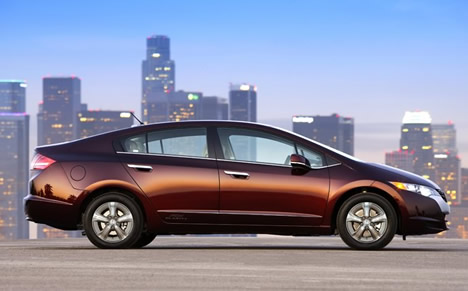 Progress Every Day!
Progress Every Day! Progress Every Day!
Progress Every Day! | |||||
| HOME | REDUCE | REUSE | RECYCLE | RETHINK | |
|
|
Home> Green Transportation
Green Transportation Everybody has to get around! We go to work, we shop, we take vacations. Americans love their cars and trucks, but as gas prices have risen steeply, many of us are taking another look at what we drive. If you are in the lucky position of shopping for a new car, there are a growing number of options with higher gas mileage. If you already have a vehicle, you are not likely to run out and replace it just to lower your gasoline bills, but there are still ways to be "greener". Saving Gas, Money, and the Environment Drive Politely. There are lots of driving tips on how to burn less gasoline. Edmonds.com tested some of them, and concluded that the best ways to improve mileage are to drive smoothly, within speed limits, and avoid idling. Of course, easier said than done if you are stuck in rush-hour traffic that crawls and stops and starts! Drive Less. The focus on WHAT we drive sometimes distracts from the aspect of HOW MUCH we drive. (In fact, researchers look at the so-called "Prius Effect" or rebound effect, where drivers of fuel efficient cars feel guilt-free and have lower fuel costs, and therefore may drive more miles.) Fuel efficiency and vehicle miles travelled are the two sides of the vehicle impacts coin. We can drive less by combining and looping errand runs, sharing commutes, using public transit, and factoring in mobility when choosing where to live. Telecommute. Telecommuting, also know as telework, is the practice of working from home or at a central telework facility closer to home, some days or everyday. For many job categories, the location of a worker's desk is less important than his/her communication skills, creativity, and technical abilities. The advantages of telework for employees are saved time and costs of transit, and often fewer work interuptions. For employers, benefits include increased worker productivity and morale, fewer demands for office space and services, and decreased costs for transit subsidy.
New Vehicle Comparisons Green Vehicle Guide: a great resource for comparing the environmental performance (mpg, carbon emissions, air quality scores) of vehicles by model and year, brought to by your friends at the EPA ... "We're from the government and we're here to help!" Although the Toyota Prius hybrid has been getting a lot of attention, the reality is that some folks need a larger vehicle to haul cargo of various sorts. Within a vehicle size class, however, there are good performers and poor performers. Being green means selecting the vehicle with best environmental performance that meets your other requirements. (But, don't forget to RETHINK...do you really need an SUV 365 days a year in order to haul your skis 6 days a year? How else could you meet your occasional needs?)
A few 2009 vehicle options are compared in the table below.
 The Honda FCX Clarity made its test debut in Southern California in summer of 2008, with a lucky few hundred drivers signing up for a 3-year lease. The car is powered by a hydrogen fuel cell, using compressed hydrogen as fuel and a lithium ion battery for electricity storage. What a spectacular vehicle...I want one! Pay-As-You-Drive Insurance Get credit for driving less than the average Joe or Jill. Pay-as-you-drive (PAYD) insurance pricing is based on a rate per mile, rather than a flat rate for the policy term. The idea has been around for awhile (here's a nice policy paper on the topic), but insurance companies have been slow to adopt PAYD. For the insurance industry, including mileage driven among the rating factors allows a more accurate prediction of risk (more miles driven correlates with higher accident risk). For consumers, a mileage based fee provides an incentive to drive less, thereby lowering personal costs (insurance) and societal costs associated with driving (e.g., congestion, noise, pollution). My current insurance policy only considers two mileage categories: under or over 7500 miles/yr. Because my actual annual mileage is well below 7500 miles, I would be a good candidate for PAYD insurance. Progressive Insurance Company offers a mileage-based insurance program called MyRate. Participants plug a small device into a diagnostic port on the steering column. The MyRate device records speed and time, and from that the company calculates number of miles driven, time of day of driving, and driving behavior. The MyRate device does not keep track of the location of miles driven, thus avoiding privacy concerns. Data are submitted via wireless communication, and policy rates are updated every 6 months. Several states (e.g., Texas, Oregon, Minnesota, and California) have passed, or are actively considering, legislation to encourage PAYD insurance.
|
Electrify Me!
|
||||||||||||||||||||||||||||||||||||||||||||||||||||||||||||||||||||||||||||||||||||||||||||
|---|---|---|---|---|---|---|---|---|---|---|---|---|---|---|---|---|---|---|---|---|---|---|---|---|---|---|---|---|---|---|---|---|---|---|---|---|---|---|---|---|---|---|---|---|---|---|---|---|---|---|---|---|---|---|---|---|---|---|---|---|---|---|---|---|---|---|---|---|---|---|---|---|---|---|---|---|---|---|---|---|---|---|---|---|---|---|---|---|---|---|---|---|---|---|
| Copyright © 2008. All Rights Reserved. | About | Sitemap | ||||||||||||||||||||||||||||||||||||||||||||||||||||||||||||||||||||||||||||||||||||||||||||||
This site is not affiliated with Green WorksTM, a registered trademark of The Clorox Company. |
||||||||||||||||||||||||||||||||||||||||||||||||||||||||||||||||||||||||||||||||||||||||||||||